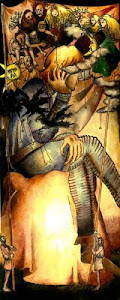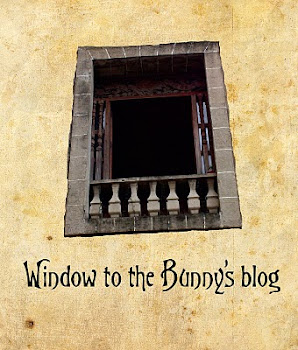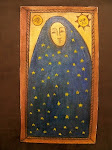 I saw this picture of an 18th century ivory statue of the Archangel Michael slaying the Devil. It can be seen (I think) at the San Agustin Church museum within the old city of Intramuros in Manila, a several kilometers and several rides away from our house in Marikina.
I saw this picture of an 18th century ivory statue of the Archangel Michael slaying the Devil. It can be seen (I think) at the San Agustin Church museum within the old city of Intramuros in Manila, a several kilometers and several rides away from our house in Marikina.
I actually see my own identity in this artwork. My country had been colonized by Spaniards for centuries. Alongside, or even before that, there had been other immigrants too, who came and affected the natives' way of living somewhat. There exists a history of Chinese traders and settlers (notably from Taiwan), Muslim folk moving from the south, and frequent interaction with merchants from India. Eventually, the Filipinos adopted some of their culture and customs, as well as their blood in some families, like mine (since my father's side had a Spanish blood, while my mother had a Chinese blood). This artwork is representative of the syncretism of the Christian, Muslim, and Chinese cultures, wrought by the fact that during these times, the native craftsmen commissioned by the clergy to make these icons had been most probably trained alongside or by Chinese artisans.

While the overall structure and theme is European (ergo, Catholic), the softness of the angel's features are Asian. Take note that 17th century Spanish figurative sculpture were given to realism rather than having a stylistic touch, for which the hyperrealism of the figures is part of the artistic rhetoric in which the devotee, upon studying the precise rendering of the icons, is driven to believe the reality behind what is depicted and thus incite further fervor. Like in the example on the left ("Christ, the Man of Sorrows"), the rendering is enough to move a 17th century church goer.
The structure of the first figurine is closer to the shaping of Buddhist carvings. This is most
evident in the modelling of the Devil at the foot of the angel, with a characteristic scowl of Buddhist deities of the menacing type, distinct from the manner of representation of western canon demons. Besides the roundedness of the body in itself, the eyes of St. Michael are softly slanting, almond shaped, traits proximal to Buddhist sculptural style tracing from the Gandhara stage (Greco-Buddhist), as can be compared to the illustration on the right, whose imagery might have migrated along with Buddhism to us from the Chinese adherents.
A surprising juxtaposition, neither Chinese nor European, may be observed from the weapon of the archangel, a short sword with a wavy length. Known as kalis in Tagalog, it is more recognized by the term kris. This weaponry was prominently developed and used by Southeast Asians (with arguably Southern origins). Having employed this element, the statuette more firmly asserts its identity as of being Filipino in origin.
My mother and my mother's parents are devout Catholics (as you seen in the picture) and, before, they collected these figurines for the altars in their homes, which I would, in turn, frequent during my childhood trips to my mother's hometown. So I guess that is the reason for my fascination in religious icons. With this kind of passion through the details on their faces filled with agony, and the level of craftsmanship present, you can tangibly feel the emotion portrayed by the artist. Though may I say that I am hardly religious myself, but their beauty does not need an inherent belief in them in order to appreciate their craft.
Also, the obscure, surreal background of my father and my paternal grandparents probably influenced my interest and curiosity about strange and fantastical things. As I told you before, my father came from his unknown, almost remote, and unusual town of Pio Duran to the capital, eventually owning a house in the suburbs. He never forgot his past, and frequently told us his mysteries and misadventures. He isn't so much unlike the father in the Tim Burton movie Big Fish, because the details of his life is woven into tall tales that are often too strange to be true. Yet, I grew up rather fascinated by his personal myths. Despite that I grew up in a suburb place, I had my curiosity to strangeness and mystery and history.

I also saw this beautiful and dramatic statue of Christ from this blog (As well as from Rima Staines' post). Look how the artist managed to depict the suffering of Christ and the drama of emotions. This sculpture would have stood for the representation of the "Christ Interred," as part of the Passion series, after the Deposition.
***
And also I found this interesting page about 100 ideas by Keri Smith. Things to do when you don't have anything to do. You can look at them here.
And days from now, I will go back to school. This is my last year in college, and I'm taking up my thesis subject and some miscellaneous subjects(including, hopefully, an elective class which teaches about watercolor techniques, and the another one about printing :)). I just miss the school, the buildings there, and the trees, and the quietness at the lagoon, and watching the sunset there.































1 comment:
You'll miss it, but you'll get so much more from it. :)
Those statues were so dramatic and heartbreaking! Its amazing that you saw those details-I appreciate art, but have never had that sort of trained eye that you do. Fantastic pieces.
Post a Comment